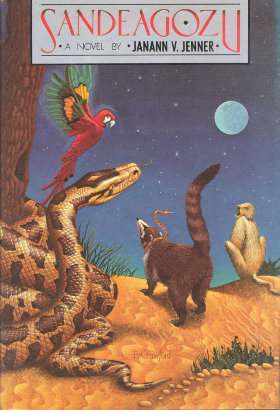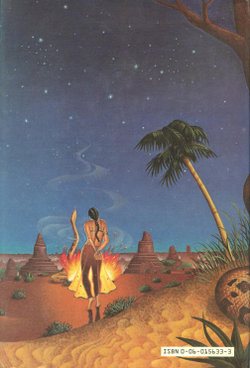Review: 'Sandeagozu', by Janann V. Jenner
 This unique and imaginative animal fantasy, set during 1932, features five cagemates from a large New York City pet shop specializing in exotic animals, who plan to escape and set out across Depression-era America for that legendary animals’ paradise, Sandeagozu – the San Diego Zoo. Led by Sherahi (“tiger killer”), the giant pythoness, the band of odd fellows consists of her, Manu the langur, Dervish the coatimundi, Dutchess the scarlet macaw, and Junior the venomous cascabel (a South American rattlesnake).
This unique and imaginative animal fantasy, set during 1932, features five cagemates from a large New York City pet shop specializing in exotic animals, who plan to escape and set out across Depression-era America for that legendary animals’ paradise, Sandeagozu – the San Diego Zoo. Led by Sherahi (“tiger killer”), the giant pythoness, the band of odd fellows consists of her, Manu the langur, Dervish the coatimundi, Dutchess the scarlet macaw, and Junior the venomous cascabel (a South American rattlesnake).
Virtually all the reviews summarize the plot as that: five exotic animals escape from a New York City pet shop to journey across America to the San Diego Zoo. Yet Sandeagozu is not exactly that, and very much more than that. That event, the meeting of the animals in the pet shop and their decision to escape together, does not begin until page 103. Jenner first builds a leisurely but fascinating backstory, rich in detail and characterization. The reader barely notices, and does not care, that the main story has yet to begin.
Illustrated by Robert Crawford. Harper & Row, October 1986, 442 pages, $18.95; ISBN: 0-06-015633-3
Sandeagozu is primarily Sherahi’s novel. It begins in 1915, with her mother’s search for a safe birthing place in the Burmese jungles. The mixture of animal fact and fantasy begins here:
The mother remembered those nervous days and was glad that they were over. ‘Now,’ she thought, for the Blessing.’ Python custom dictated that each brooding female could bestow a single blessing in her lifetime. This blessing would enable the chosen hatchling to develop the unique mental powers possessed by many members of the Elder Race, but most often reserved for those that the pythons called the Leather Skins: crocodiles and their kin. Bestowing her blessing was a heavy responsibility and the pythoness had already scryed the embryonic minds of most of her children. ‘There must be one unusual one in this clutch,’ she thought. ‘I can’t waste the gift on an ordinary child. I must find the right one. They’ll begin to hatch very soon and then it’ll be too late.’ (pg. 3)
The opening pages describe Sherahi’s early life in the wild. Again a mixture of nature lore and fantasy, they establish all animals’ telepathy:
She saw the old serpent [U Vayu] crawl beneath the altar of the glinting statue of the Buddha and form a compact coil. He settled his wide head on the topmost curve of his neck and then suddenly glared at her. ‘Go away, Sherahi,’ he ordered in a voice that she had to obey and she felt him abruptly shut his mind to her intrusive probe. It was like the slamming of a heavy, metal-studded door. She heard his sibilant hiss and he repeated, ‘Go away, Sherahi. The rituals are serious. Not play for babies.’ (pg. 14)
And also the “snake tongue” which describes their reptilian biological traits:
Sherahi’s thoughts were interrupted by the faint quopping of her labial pits and she fnasted the trail of a mother rat. (pg. 14)
More importantly, the telepathy enables all animals to communicate with each other. Sherahi converses with other snakes, bats, and the Great Serpent Nats who are the ophidian gods such as Quetzalcoatl, the Feathered Serpent, the Great Worm Ouroboros, Jormungand the Midgard Serpent, and Lachesis who was a great serpent but is now a caterpillar. These are throwaway scenes, but they establish how later the animals in the pet shop are able to plan their mutual escape and trek across America.
In 1921 Sherahi is captured and brought to America, where she spends years as a living prop in Naruda, Exotique Dancer and Snake Charmeuse’s burlesque routine. Jenner also tells Naruda’s, née Ruthie Notar’s, life story in colorful detail. The street-smart Ruthie and Sherahi love each other, but by 1932 Sherahi has grown so large that Ruthie has increasing trouble caring for her in the urban U.S. Add that Ruthie has just been offered a movie contract, and Ruthie’s boyfriend Bernie is finally able to convince her to trade Sherahi in for $75 and several smaller boa constrictors. The story switches to that of Ira Leftrack, proprietor of Leftrack’s Pet Emporium and Animals International Ltd. of New York City. We learn all about Ira, his meek wife Irma, his spoiled, fat son Ehrich, his underappreciated assistant Birger Sorensen; and Jenner makes it so interesting that we would hardly care if she spent the whole book just talking about them.
Leftrack has built up an active business in both regular pets and importing exotic animals for sale to zoos. Yet every so often he gets stuck with “Culls”; animals that are unsaleable for one reason or another. At this time they include Manu the langur monkey, badly scarred in a savage beating by a bigger monkey; Dutchess the neurotic macaw who has plucked out all her feathers; Dervish the young coatimundi who is always getting loose and causing trouble; Junior the dangerous rattlesnake – and, after a three-month hunger strike from the disappointment of being abandoned by Ruthie, plus untreated mouth rot, the emaciated and listless Sherahi.
But Sherahi, who has had enough of being “betrayed” and mistreated by humans, plans a breakout of the Culls.
Manu turned to the Dutchess and Dervish and said, ‘Sherahi wants to take us to Sandeagozu. It’s a wonderful place. I’ve heard Sorensen and Leftrack talk about it many times. Only the luckiest, most beautiful animals get to go there. It’s always warm in Sandeagozu and there’s lots of food and sunshine, and …’ he added, looking at Dervish, ‘lots of playmates and mates.’ (p. 120)
 Sherahi and Manu have to struggle to convince the other three to trust them (the Dutchess is sure it’s all a plot for one of the snakes to eat her); then, once they are out, to stay together for their mutual benefit. They face many dangers, not only from humans but from other animals, starting with those hidden beneath them; the rat nations of the subway tunnels, and the crocodiles of the sewers who prove much less trustworthy than expected:
Sherahi and Manu have to struggle to convince the other three to trust them (the Dutchess is sure it’s all a plot for one of the snakes to eat her); then, once they are out, to stay together for their mutual benefit. They face many dangers, not only from humans but from other animals, starting with those hidden beneath them; the rat nations of the subway tunnels, and the crocodiles of the sewers who prove much less trustworthy than expected:
Dervish and Junior would search for an entrance to the tunnels of the Holy White Crocodiles tonight. The crocodiles were the key to the entire plan, because if anyone could tell the Culls how to find Sandeagozu, they could. They weren’t just ordinary crocs. On the contrary, the white crocodiles were highly specialized and frighteningly intelligent descendants of the ordinary Nile crocodiles who had entered the underground water supply of this city by chance, evolving there in isolation for hundreds of years. (p. 148)
The novel is not halfway through, and the surprises are just starting. Can they successfully cross the United States together? Why, for the longest time, it seems like they will never get out of New York City! What ultimately happens to the five is neither what they nor the reader expect, but the ending is fitting and should not disappoint. Sandeagozu stands apart from anything else that you have ever read.
About that “illustrated by Robert Crawford”: don’t expect anything more than an interior black-&-white copy of the front of the wraparound cover painting.
About the author
Fred Patten — read stories — contact (login required)a retired former librarian from North Hollywood, California, interested in general anthropomorphics
Comments
Thank you for your comments, Fred.
It has been a long time since anyone mentioned my novel, Sandeagozu, and I so appreciate having had such a thoughtful and insightful reader. Sadly, the book sank beneath the waves of publishing about six months after it appeared. I am delighted that you enjoyed the book and have made it a bit more accessible to other readers.
All best,
Jan Jenner
I was so happy to be reminded of this enchanting story! I just ordered it and will read one again!
I was reminiscing with Bob McLaughlin about you and your time here. I thought I would find you on the web, but you are as anonymous as I am. Just thought I'd say hello. Joe
Dear Anon,
I am happy you will be re-reading. I had feared to re-read it myself, having been so downcast when it disappeared beneath the waves, but I did re-read and was pleased with it. Sandeagozu sure isn't a perfect novel, but it was the best I could do and I'm unsure I could do better now, after all these years and much more writing experience. I sure did love those characters.
Hope you enjoy this visit to Sandeagozu.
All best,
Jan Jenner
Dear Jan,
Many of us love your characters also! That it "disappeared beneath the waves" was a total injustice. It remains unique and one-of-a-kind. As an AMNH Tour Guide, it continues to serve as a reminder to me of how to tell a story and communicate with an audience. Thank you!
I have always loved this treasure of a book that i stumbled upon years ago. It is on my Facebook list of top ten novels that should have inspired movies. Thank you Jan.
Post new comment